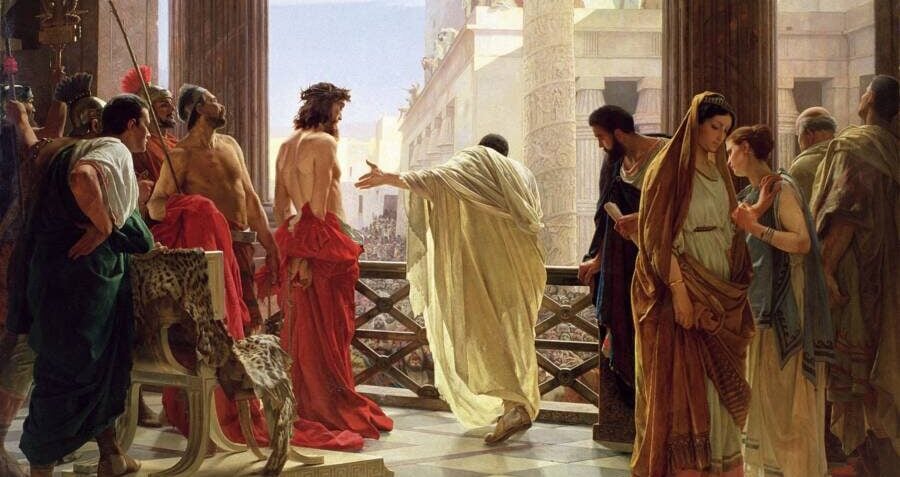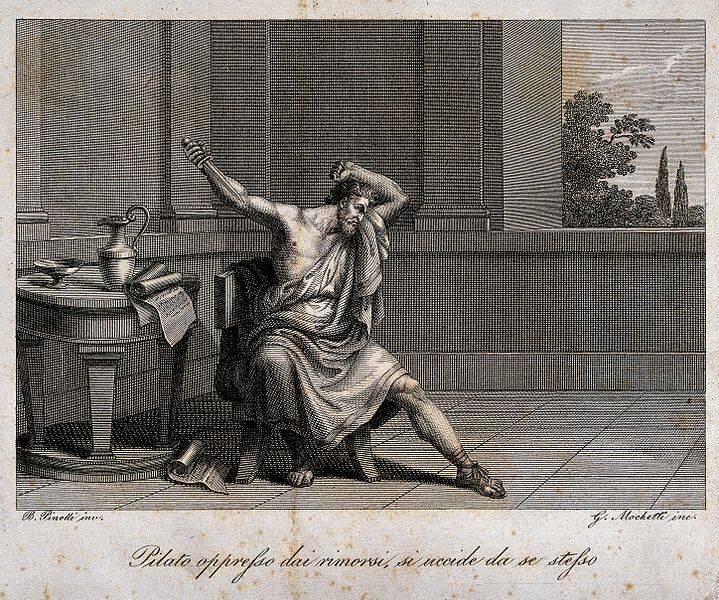Best known as the man who sentenced Jesus to death, Pontius Pilate remains a controversial figure in both biblical and historical texts.

Public DomainEcce Homo (Behold the Man) by Antonio Ciseri, c. 1860-1880.
Pontius Pilate was the Roman governor of Judaea, now modern-day Palestine and Israel, for roughly 10 years. Best remembered by history for his role in the crucifixion of Jesus Christ, Pilate is a historical figure otherwise shrouded in mystery.
Conflicting historical and biblical accounts of Pilate paint him as either a ruthless tyrant uninterested in the laws and sensitivities of his subjects or an unsure and frustrated leader — and even the circumstances surrounding his fateful condemnation of Jesus Christ are somewhat murky.
This is what we know about Pontius Pilate, the man who infamously sentenced Jesus to death.
Pontius Pilate As The Governor Of Judaea
Pontius Pilate was the fifth governor of Judea from 26 C.E. to 36 C.E. under the rule of Roman Emperor Tiberius. But the historical record of Pontius Pilate’s life before he became governor is scant.
History reports that some scholars believe he was born in Italy and came from an equestrian family — part of the Roman nobility. Still, this is all informed guesswork.
From there, it’s believed he may have joined the military, largely based on Pilate’s name. The word “Pilatus” means “armed with a javelin,” suggesting Pilate may have served in the military as a skilled javelin thrower.
“On the basis of information about other [Roman] governors and about how the Roman imperial system maintained control, we can reasonably guess that Pilate probably had some sort of military career in which he most likely distinguished himself in some way as an officer,” wrote New Testament scholar Warren Carter in his book Pontius Pilate: Portraits of a Roman Governor. “We can also be fairly confident that he belonged to the upper stratum of Roman society, that his family was wealthy.”
According to historian Daniel R. Schwartz in his book Anchor Bible Dictionary, Pilate was appointed a prefect. This was a high-ranking role that involved supervising a region’s finances and military, as well as acting as chief justice and head of civil service. Because he was the Roman representative of a Jewish-majority area, Pilate shared duties with an elite Jewish council called the Sanhedrin.
During his ten years in this role, Pilate collected taxes and oversaw Judea’s construction projects. However, he is most infamous for his role in maintaining law and order in the region.
Historical Concerns About Pilate’s Rule Over Judaea
Although Pontius Pilate held power alongside a Jewish council, historians agree that he had a turbulent relationship with those whom he governed.
According to Flavius Josephus, a Roman-Jewish first-century historian, in his book The Wars of the Jews, Pilate once angered the local Jewish population by ordering that images of Caesar be placed in Jerusalem.
As Paul L. Maier translated in The Roman Governors, Josephus wrote that Pilate “intended to subvert the Jewish customs by introducing into the city busts of the emperor that [stemmed from] military standards when our law forbids the making of images.”
When the people protested, spending five days rioting against the images, Pilate is said to have ordered his soldiers to surround them and threaten them with death if they did not stop protesting. When the Jews said they’d rather die than see their laws broken, he relented and had the images removed.
Additionally, Josephus writes that Pilate offended the Jews once more by using Temple funds to build aqueducts to Jerusalem. When a mob formed to confront Pilate, he allegedly had his troops brutally beat them until they dispersed — or died.
The Gospel of Luke also recalls an instance of brutality in Pilate’s rule, stating:
“Some of those in the crowd informed Jesus that Pilate had slaughtered some Galilean Jews while they were offering sacrifices at the temple, mixing their blood with the sacrifices they were offering.”
Evidently, historical accounts depict Pilate as a harsh and sometimes cruel ruler willing to use force to keep the people of Judaea in line. But many biblical texts show Pilate in a more sympathetic light, despite the fact that Pilate was the one who sentenced Jesus to death — and some Christian churches even recognize the Roman prefect as a saint.
The Trial And Crucifixion Of Jesus Christ

Svabo/Alamy Stock PhotoA statue of Pontius Pilate and Jesus in Rome.
According to the Gospel, the Sanhedrin had Jesus arrested because they felt threatened by his teachings, alleging he claimed be the “King of the Jews,” which would have been considered both blasphemy and treason.
Soldiers took Jesus to Pontius Pilate for judgment, but Pilate was reluctant to convict him. The Gospels depict Pilate as being conflicted and indecisive in contemplating Jesus’ fate.
“What charges are you bringing against this man?” he asked the Sanhedrin.
“If he were not a criminal,” the Jewish council replied, “we would not have handed him over to you.”
Not seeing any legal grounds to sentence Jesus to death, Pilate attempted to defer the responsibility, telling the Jewish elders, “Take him yourselves and judge him by your own law.” But they refused. After all, Pilate was the only one with the authority to order the death penalty, and they wanted Jesus executed.
According to the New Testament, worn down by their insistence, Pilate eventually gave in to the demands of the Jewish authorities and ordered that Jesus be crucified. It’s said that at that point, Pilate literally washed his hands before the Jewish council, denying his responsibility and instead blaming the Jews. As Matthew writes:
“When Pilate saw that he was gaining nothing, but rather that a riot was beginning, he took water and washed his hands before the crowd, saying, ‘I am innocent of this man’s blood; see to it yourselves.'”
Later, Pilate is said to have ordered that “Jesus of Nazareth, King of the Jews” be inscribed on Jesus’ cross. While some think this was meant to mock Jesus, others believe he meant it in earnest and that he really did come to view Jesus as the King of the Jews.
Pontius Pilate’s Mysterious Final Years

Wellcome ImagesEmperor Pilate attempting suicide after being disgraced.
According to the Letters of Herod and Pilate, a collection of letters some believe to be the real correspondence between Pontius Pilate and King Herod, Pilate was reportedly tormented by guilt after Jesus’ crucifixion at Golgotha.
In one letter, Pilate speaks of meeting a resurrected Jesus and repenting for his role in Jesus’ death.
“But we, when we saw him, all of us fell upon our faces before his feet. And I said with a loud voice, I have sinned, O Lord, in that I sat and judged thee, who avengest all in truth. And lo, I know that thou art God, the Son of God, and I beheld thy humanity and not thy divinity. But Herod, with the children of Israel, constrained me to do evil unto thee. Have pity, therefore, upon me, O God of Israel!”
And although many scholars doubt the authenticity of these letters, these texts do explore one theory about what happened to the governor after Jesus’ crucifixion: that he converted to Christianity and became a devout follower of Jesus.
According to other, more reliable historical accounts, Pilate lost his position after he reportedly massacred a group of Samaritans who had been trying to ascend a mountain in search of sacred relics they believed Moses had buried there.
Other Samaritans complained about Pilate’s excessive use of force to Vitellius, the Roman governor of Syria, who held a higher political position. Hearing these disturbing complaints, Vitellius sent Pontius Pilate back to Rome to discuss his actions with the Roman emperor himself.
The record of Pilate’s life generally ends here, and historians aren’t sure if he made it back from Rome. If he did, the emperor likely removed him from his post or he retired, as he never returned to rule over Judaea.
While some sources say Pontius Pilate converted to Christianity, others suggest his ending was darker. Some believe Roman Emperor Caligula had Pilate executed, or that Pilate was exiled and died by suicide.
With very few historical texts to rely on, the truth of this elusive historical and religious figure has largely been lost to time.
After reading about the life of Pontius Pilate, dive into this historical investigation into who wrote the Bible. Then, read about the bizarre true story of Roman Emperor Caligula.





